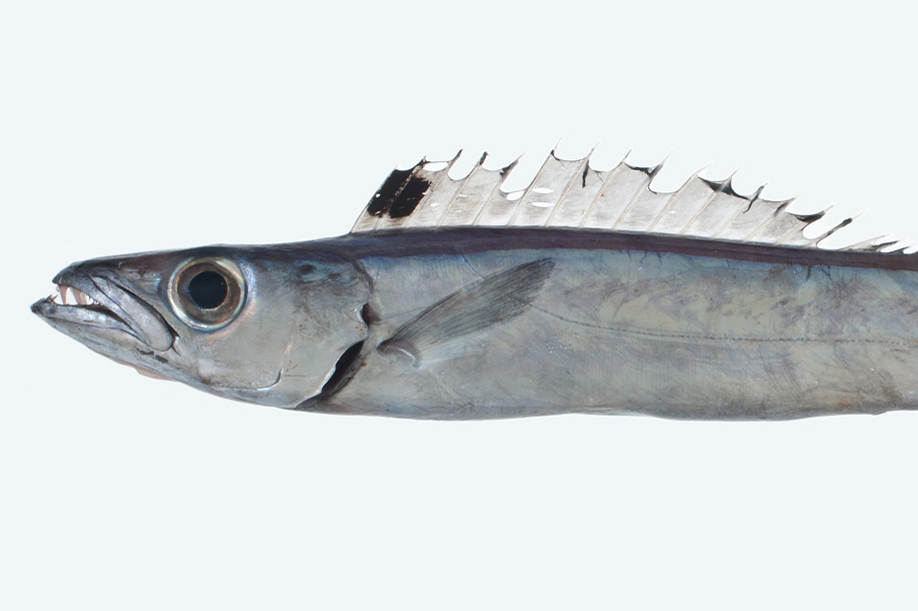- Classification
- ACTINOPTERYGII
- PERCIFORMES
- GEMPYLIDAE
- Rexea
- antefurcata
Longfin Gemfish, Rexea antefurcata Parin 1989

A Longfin Gemfish, Rexea antefurcata, collected during the 2003 NORFANZ Expedition to survey the seamounts in the Tasman Sea. Source: Robin McPhee / NORFANZ Founding Parties. License: All rights reserved
The Longfin Gemfish bites larger prey into pieces before swallowing it.
Longfin Gemfish, Rexea antefurcata Parin 1989
More Info
|
Depth |
from 126 to 770 m |
|
Distribution |
Distribution restricted to southern Pacific and southern Indian Ocean. In Australian waters found along the west coast from Carnarvon to North West Cape (WA) and along the east coast from Swains Reef (QLD to ) Gabo Island (VIC). An oceanic species, benthopelagic, found in depths from 126 to 770 m. Schools of this species migrate to mid-water at night. |
|
Features |
D XVIII-XIX, 0, I, 15-17; A II, 12-34; P 13-14. Pelvic fins reduced to tiny single spine in juveniles, absent in adults. Second dorsal and anal fins followed by two finlets. Body elongate and compressed. Body depth 6-7 times into standard length. Head length 3.0-3.5 times into standard length. Lower jaw protrudes, both jaws without dermal processes. Three to five pairs of rigid, and 1-3 pairs of depressible fang-like teeth in upper jaw, One pair of fang-like teeth in lower jaw. Lateral line bifurcated below third to fifth first dorsal fin spine, the upper lateral line reaches end of second dorsal fin base, lower lateral line mid-lateral to caudal fin origin. Body naked, except wedge-shaped stripe of small scales extending forward from caudal peduncle along horizontal section of upper lateral line. |
|
Size |
To at least 75 cm. |
|
Colour |
Body grey or brown with metallic tone. First three membranes of first dorsal fin jet-black, the remainder of the fin blackish. Pectoral fins grey. |
|
Feeding |
Known to feed on fishes (myctophids, macrourids and carangids), cephalopods and crustaceans. Larger prey is bitten into pieces before it is swallowed. |
|
Biology |
Matures at 25 cm (SL). |
|
Fisheries |
Of no particular interest to fisheries, but known to be taken as bycatch in prawn trawls. |
|
Conservation |
None. |
|
Species Citation |
Rexea antefurcata Parin 1989, Voprosy Ikhtiologii 29(1):19 [101], Fig. 6, Sala y Gomez Ridge, 25°34'S, 89°12'W, southeastern Pacific, depth 560-590 meters. |
|
Author |
Schultz, S. |
Longfin Gemfish, Rexea antefurcata Parin 1989
References
Carpenter, K.E.; Niem, V.H. (eds). FAO species identification guide for fishery purposes. The living marine resources of the Western Central Pacific. Volume 6. Bony fishes part 4 (Labridae to Latimeriidae), estuarine crocodiles, sea turtles, sea snakes and marine mammals. Rome, FAO. 2001. pp. 3381-4218.
Hoese, D.F., D.J. Bray, J.R. Paxton, & G.R. Allen. 2006. Fishes. in Beesley, P.L. & A. Wells. (eds) Zoological Catalogue of Australia. Volume 35. ABRS & CSIRO Publishing: Australia. parts 1-3, pages 1-2178.
Nakamura, I. and N. V. Parin. FAO species catalogue. Vol. 15. Snake mackerels and cutlassfishes of the world (Families Gempylidae and Trichiuridae). An annotated and illustrated catalogue of the snake mackerels, snoeks, escolars, gemfishes, sackfishes, domine, oilfish,cutlassfishes, scabbardfishes, hairtails, and frostfishes known to date. FAO Fisheries Synopis. No. 125, Vol. 15. 1993. 136 p., 200 figs.


